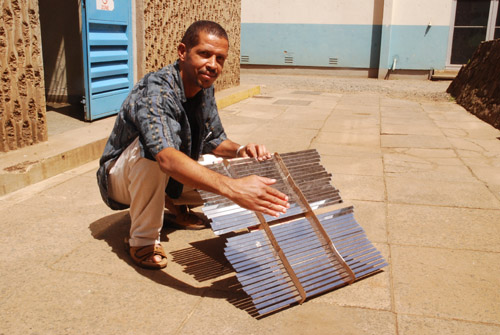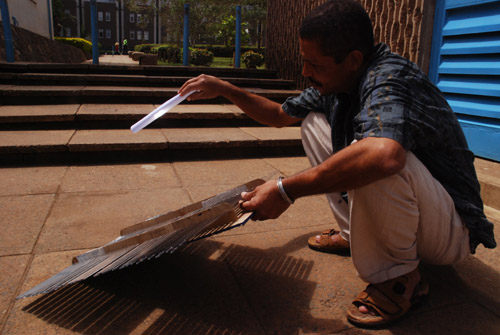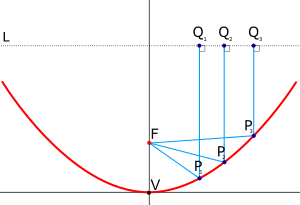Can a parabolic mirror be flat? Dominic Wanjihias latest invention may prove that this is the most efficient way of capturing solar energy.

Everyone knows what a parabolic reflector is, right? It’s supposed to be a curved surface that collects energy by converging it towards a focus. Parabolic reflectors were invented a very long time ago and have been used in satellite dishes, spot lights and car headlights to name a few. They are also widely used for alternative energy projects to concentrate solar energy for heating and cooking.
Dominic (designer of the flexible solar vest, the solar dryer, and camel milk cooler for Somalia) thinks that the parabolic mirror should lose it’s shape which is an obstacle, to transportation and function.
So how does the flat parabolic mirror work? Dominic has cut inch wide 2 foot long pieces of flexible acrylic mirrors and arranged them at specifically computed angles. When angled towards the sun, this creates a perfectly focused beam of light.

This concentrated energy can be used to heat water in a pipe for numerous purposes including generating electricity. The beauty of this gadget is that
- It is very cheap,
- It can be quickly dismantled or moved,
- It is easily transportable as it can be carried flat or in a tube,
- It is easily repaired if broken as the individual mirror pieces can be replaced (rather than having to fix or replace an entire parabolic mirror).
Please note that this is part of Dominic Wanjihia’s ongoing project with Nairobi University and MIT’s FabLab where he is doing a course.
 .
.



That would be a fresnel reflector then. Like a fresnel lens.
@ Beardy Thought so too. Any leads on how a fresnel lens can be made? Within reasonable limits…? I had a project in mind and couldn’t find one
Hmm. That’ll be a little more tricky because a lens is all about refraction.
However, you can reclaim ≈12″ square fresnel lenses out of old OHP projectors and if you’re feeling lucky you can get HUGE ones out of old projection TVs.
Obviously, it must be said, you proceed at your own risk. Concentrated sunlight is extremely dangerous – especially to eyes!
Have fun!
To make a round fresnel reflector, find a shiny bowl/dish of a nearly parabolic shape that matches the focal length you’re looking for, then draw parallel lines along the outside of the bowl at intervals determined by desired thickness of the end reflector, then cut along the lines. You’ll then have a series of nested rings, all of which have the same reflected focal point.
Note, this wouldn’t work with a dish that is already calibrated to a single focal point, because you’ll be moving the rings from their original position. You’ll need a dish that has a sliding scale of foci, so that they’ll all line up when the rings have been laid out on a surface.
Consider the cartesian diagram in the post above. If you moved sections P1 P2 and P3 to the plane called V, the rays Q1 Q2 and Q3 would no longer have the same focal point. They would still reflect across the axis F, but they wouldn’t be correctly aligned.
There are flat magnifiers sold in office product stores which are fresnel lenses. The large ones are 8.5×11 inches. Probably not as good quality as those in projection televisions, but they are good enough to do some things.
Edmund Scientific has been selling fresnel lenses since forever. Check them at scientificsonline.com. They have an 11″ square fresnel for $6.95. They also have other cool science/education stuff too.
I am very impressed by your work blogger; I am a Kenyan student studying in the states who recently entered the blogosphere. This site is defintely an inspiration as I try to write original articles about Kenya with a focus on “Things North Kenya”. Please check out my site and give me some tips
Hi,
I am not an engineer, but some time ago I realized the following problems in big cities in developed countries (NY, Paris, or Berlin where I am from):
If you live in a rent apartment there, you don´t get much light, because the houses are built in certain ways (too closed, narrow, etc.).
So my roommate and I contemplated about installing mirrors on the opposite side, the neighbours’ side, which will redirect the light into your window. Additionally the partnering neighbour may get also some electricity from it. Some quick research revealed that these parabolic mirrors are very expensive here in Germany.
So as I am not an engineer, my question to the community here, is the following:
– Is the proposed solution feasible and cheap? Is redirecting possible?
Would love to hear from you, and might work on a business model (if technology is possible).
Kindly Regards,
Simon
Simon,
Since you are in Berlin you should go visit the roof of the Reichstag where they have implemented a very large-scale version of what you propose. There are smaller versions such as the solar skylight(at http://store.sundancesolar.com/18nalituskki.html). So others have at least started implementing similar solutions although not exactly the same as what you wanted. Good luck and maybe you will find something that would work for you.
Interesting discussion…I’m not an engineer but hope that Dominic can respond to all of these comments sometime soon! Wikipedia has something on Fresnel lenses used in solar power plants here http://en.wikipedia.org/wiki/Concentrating_solar_power which looks similar to what Dominic is trying to do.
The cheapest I have seen Fresnel lenses is – they are sold in the US in drugstores, at the pharmacy counter, for old people who can’t see/read. They usually have them in various sizes, including credit-card size, and are only a couple dollars at the counter (Not 6.99 – that is pricey) Of course wholesale would be cheaper.
Or if there is a round clear glass vase – as close to a sphere as possible – you can fill it with water and it will act like a magnifying glass. (Here people’s things catch on fire when they put a fishbowl in the sun!)
In the old days they would put clear spheres with water in front of a candle at night, to magnify the light.
Probably you know all this…
Hi. And where can one buy fresnel lenses in Kenya? I mean good enough for solar cooking.